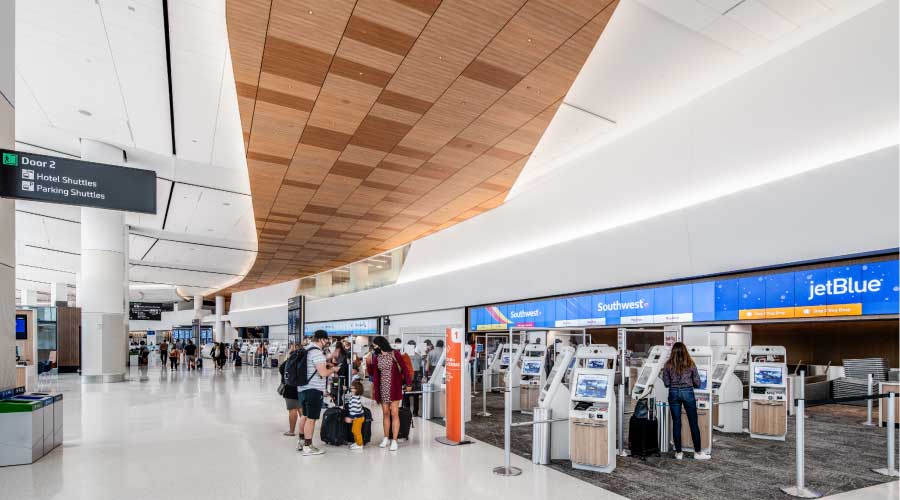Using Post-Occupancy Evaluations to Fine Tune Green Design
PRESENTED BY THE U.S. GREEN BUILDING COUNCIL AND BUILDING OPERATING MANAGEMENT
With the critical mass of LEED projects that have now been built, the million dollar question is, how well are they working? One way to find out is by performing a post-occupancy evaluation.
Unlike commissioning, which focuses on the operations of HVAC, electrical and water systems, a post-occupancy evaluation focuses on the people who inhabit the facility. Commissioning and measurement and verification are the best ways to develop strategies for reducing energy consumption, but they are not likely to reveal how the occupants feel about the facility or to give an idea of how the work environment affects their productivity.
Given the relative value of utility costs (approximately $2 to $3/sq. ft.) vs. average employee costs (approximately $250 to $300/sq. ft.), having comfortable and productive employees and building occupants could add more to the bottom line than reductions in energy costs. While reducing energy consumption is critical for many reasons, and significantly easier to quantify than productivity, it should be one focus — but not the only focus — of building operations.
Using a Post-Occupancy Evaluation
A post-occupancy evaluation is a survey, often performed online, that includes questions for building occupants about many aspects of the facility and operations, including thermal comfort, indoor air quality (IAQ), lighting quality, cleanliness, work environment, furniture and more. The goals for the post-occupancy evaluation should be to gauge employee satisfaction and identify modifications that will enhance comfort.
When using the LEED for New Construction rating system, facility managers can receive one point for doing an occupant survey that assesses thermal comfort. Achieving the point requires that a survey be performed six to 18 months after the facility has been occupied. If more than twenty percent of respondents are dissatisfied with thermal comfort, the building owner or operator agrees to modify the systems to increase satisfaction. LEED for Existing Buildings: Operations and Maintenance also offers a point for an occupant survey that addresses thermal comfort.
A commonly used online survey, which can be customized for your facility, is provided by the Center for the Built Environment (CBE). American Technical Publishers (ATP), whose facility in Orland Park, Ill., recently achieved LEED Gold certification, used this survey. Mike Tarasiewicz, ATP's director of information and building systems, says the survey was very important to assessing the effectiveness of the building. "It was much more than getting a LEED point," he says. "We conducted the evaluation to get honest feedback from our employees and tenants. Our goal was to give our employees and tenants a chance to express their opinions in an anonymous forum."
ATP chose questions from CBE's database and customized them to meet the specific needs of their building. They also added their own questions. Even though LEED only requires thermal comfort questions, ATP chose questions regarding acoustics, air quality, cleanliness and maintenance, lighting, office furnishings, office layout, thermal comfort, and general satisfaction.
ATP wanted to find out what they had done right and what needed to be adjusted or changed. They also wanted to know how the building and its occupants interact and whether they really do have a better building due to their commitment to getting it LEED certified.
The survey validated ATP's green building efforts: Overall satisfaction with the building was 96 percent. Even so, some areas, such as thermal comfort, were targeted for improvement. Specific areas of the building were reported to be too warm or too cool. Based on the survey results, ATP modified the HVAC and building automation systems to address the occupants' needs.
Changes were also made to the window shades to reduce glare on computer screens, and ATP enhanced its employee education program, especially to strengthen awareness of its recycling program.
When asking post-occupancy questions, allow respondents to give specific details about suggested changes to the facility. The CBE survey provides follow-up questions in case responses don't indicate satisfaction, and gives plenty of space for specific comments.
Starting With Design
To have the most impact on how the facility will operate for the long term as well as employee satisfaction, it is critical that facility managers play a significant role early in the design phase of a project. Designers (and LEED consultants) often hold a half- to full-day "design charrette" (workshop) early in the project. The facility manager is often invited, but some only come for an hour or don't show up at all.
Some facility managers don't think they can have much influence during the project's design phase. Besides, they are usually very busy, and attending a design meeting may not be at the top of their priority lists. However, for all projects, and especially LEED projects which take a more integrated approach, both facility managers and building occupants can have a significantly positive impact on building design.
For example, in one design charrette, the building occupants asked for good daylight, views and IAQ. With such strong direction, the architect designed the building to meet those goals and the owner did not value engineer out the additional clerestories and IAQ features. Clearly, facility managers have a unique opportunity to help maximize satisfaction by being involved in the design of a facility from early on. "Fixing it later" does not need to be an option.
Korina Tweed, property manager for Exelon in Chicago, agrees. Tweed just completed a one-floor addition to Exelon's 10-floor LEED Platinum space located in Chicago's Chase Tower.
"The integrated approach is key," she says. "First, it allowed the project team to fully understand Exelon's expectations and the steps we needed to take to achieve our goals from the very start. It's also important to ensure that the team is on the same page because every change or update affects all the trades involved. Having everyone integrated from the beginning saved us from needless change orders and additional costs to the project."
Tweed also emphasizes how important it was to be involved in the project early. "My advice would be get on board and very involved from the earliest stage," she says. "From a facility management perspective this was much easier said than done but worth it in the long run. By being involved from the beginning it allowed me to understand the process and oversee the schedule and budget. It also allowed me to keep the business side well informed as to the project's details and ample time to coordinate move in."
Shortly after Exelon's initial 10 floors were built, the organization conducted a post-occupancy survey to determine satisfaction with the new space relative to old spaces from which employees had moved. More than 50 percent were more comfortable in the new space and 42 percent found the new space to better promote spontaneous interactions, collaboration, cooperation and teamwork (even though everyone is in a private office or cubicle). Due to the overall satisfaction with the initial project, the same features were included when a one-floor addition was built.
Because they've proven time and again to be valuable indicators of occupant satisfaction, post-occupancy surveys of LEED projects are becoming more common. As facility managers continue on their paths to more sustainable facilities, it's important to remember to assess and evaluate what's been accomplished, learn from it, and improve upon it.
Helen J. Kessler, FAIA, LEED A.P. is president of HJKessler Associates, a Chicago-based sustainable design consulting practice. She is a board member of the USGBC Chicago Chapter, co-chair of the education and research committee and director of its education "pillar." Kessler can be reached at hjkessler@hjkesslerassociates.com.
Results From the Field
The Chicago chapter of the U.S. Green Building Council recently performed a survey of 25 LEED projects in Illinois. Results from the survey included:
1. The focus on sustainability should not stop after the design and construction phase. Tracking the use and cost of energy, water, and other resources regularly to establish operation and maintenance practices that improve performance is an important component of a sustainable building.
2. A building's best benchmark is its own performance. Buildings are constantly in flux as their use, occupancy, systems and other factors change over time. Understanding the impacts of these changes is critical to evaluating building performance.
3. Ongoing performance evaluations should provide relevant and actionable feedback to facility managers and building occupants. The feedback should be easy to understand. It is especially valuable for informing future decisions, particularly continuous improvement strategies.
Read more about the survey.
|
Related Topics:













